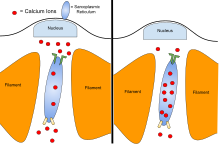Anaerobic exercise

Anaerobic exercise is a type of exercise that breaks down glucose in the body without using oxygen; anaerobic means "without oxygen".[1] In practical terms, this means that anaerobic exercise is more intense, but shorter in duration than aerobic exercise.[2]
The biochemistry of anaerobic exercise involves a process called glycolysis, in which glucose is converted to adenosine triphosphate (ATP), the primary source of energy for cellular reactions.[3]
This type of exercise leads to a buildup of lactic acid.[1]
Anaerobic exercise may be used to help build endurance, muscle strength, and power.[4][5]
Metabolism
In contrast, aerobic exercise includes lower intensity activities performed for longer periods of time.[1] Activities such as walking, jogging, rowing, and cycling require oxygen to generate the energy needed for prolonged exercise (i.e., aerobic energy expenditure). For sports that require repeated short bursts of exercise, the aerobic system acts to replenish and store energy during recovery periods to fuel the next energy burst.[11] Therefore, training strategies for many sports demand that both aerobic and anaerobic systems be developed. The benefits of adding anaerobic exercise include improving cardiovascular endurance as well as build and maintaining muscle strength and losing weight.

The
- The alactic anaerobic system, which consists of high energy creatine phosphate; and[12]
- The lactic anaerobic system, which features anaerobic glycolysis.[12]
High energy
The by-product of anaerobic glycolysis—lactate—has traditionally been thought to be detrimental to muscle function.[13] However, this appears likely only when lactate levels are very high. Elevated lactate levels are only one of many changes that occur within and around muscle cells during intense exercise that can lead to fatigue. Fatigue, which is muscle failure, is a complex subject that depends on more than just changes to lactate concentration. Energy availability, oxygen delivery, perception to pain, and other psychological factors all contribute to muscular fatigue. Elevated muscle and blood lactate concentrations are a natural consequence of any physical exertion. The effectiveness of anaerobic activity can be improved through training.[14]
Anaerobic exercise also increases an individual's basal metabolic rate (BMR).[15]
Examples
Anaerobic exercises are high-intensity workouts completed over shorter durations, while aerobic exercises include variable-intensity workouts completed over longer durations.[2] Some examples of anaerobic exercises include sprints, high-intensity interval training (HIIT), and strength training.[16]
See also
- Aerobic exercise
- Bioenergetic systems
- Margaria-Kalamen power test
- Strength training
- Weight training
References
- ^ a b c "Anaerobic: MedlinePlus Medical Encyclopedia". medlineplus.gov. Retrieved 21 March 2022.
- ^ )
- ^ Cooper, Geoffrey M. (2000). "Metabolic Energy". The Cell: A Molecular Approach (2nd ed.).
- PMID 21904277– via Google Scholar.
- S2CID 34135496.
- PMID 15958171.
- PMID 12825337.
- S2CID 851358.
- PMID 10647856. Archived from the original(PDF) on 27 July 2011.
- ISBN 978-1-60327-382-4.
- S2CID 237797609.
- ^ ISBN 0443066426
- S2CID 14589259.
- ISBN 978-0-691-02376-2.
- ^ Scott, Plisk Steven (February 1991). "Anaerobic metabolic conditioning: a brief review of theory, strategy and practical application". Journal of Strength and Conditioning Research. 5 (1): 23–34. Retrieved 30 April 2020.
- ^ Atkins, William A. (2 December 2016). Loy, Loy (ed.). "Anaerobic Exercise". The Gale Encyclopedia of Fitness. Retrieved 23 October 2023.
